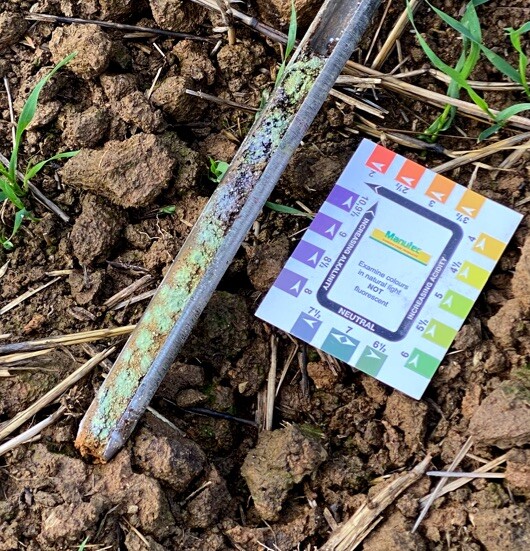Managing acid soils in the Riverine Plains
Understanding how to measure your soil acidity and incorporating appropriate liming strategies are crucial management tools in soil health.

Soils in the Riverine Plains region can be complex, with constraints segmented across the profile. Soil acidity is a classic example of this, with some soils not being acidic in the topsoil but being profoundly acidic beyond 15cm depth.
While some soils in north east Victoria and southern NSW are naturally acidic due to their parent material, others are becoming more acidic due to agricultural production. The ongoing use of nitrogen and the export of agricultural produce (which extracts calcium, magnesium and other cations from the soil) all result in net soil acidification.
Soils with pH layers of 4.8 or 4.5 (or lower) in the subsurface can severely constrain root growth, affect water and nutrient uptake and limit crop choice. The effects of soil acidity might not be noticeable in a good season as plants can still extract water and nutrients from the topsoil. However, acidity can significantly impact biomass production and yield potential in very dry or wet years.
Are your soils acid?
Soils in the Riverine Plains region can be complex, with constraints segmented across the profile. Soil acidity is a classic example of this, with some soils not being acidic in the topsoil but being profoundly acidic beyond 15cm depth.
While some soils in northeast Victoria and southern NSW are naturally acidic due to their parent material, others are becoming more acidic due to agricultural production. The ongoing use of nitrogen and the export of agricultural produce (which extracts calcium, magnesium and other cations from the soil) all result in net soil acidification.
Soils with pH layers of 4.8 or 4.5 (or lower) in the subsurface can severely constrain root growth, affect water and nutrient uptake and limit crop choice. The effects of soil acidity might not be noticeable in a good season as plants can still extract water and nutrients from the topsoil. However, acidity can significantly impact biomass production and yield potential in very dry or wet years.
The best way to identify constraints such as acidity is through regular soil testing (ideally every three years). Understanding a soil’s baseline physical and chemical properties will help pinpoint areas where soil limitations such as acidity are holding back your system and if these change over time. Soil testing is the best way to address these issues to ensure soils are healthy enough to support your farming system.
How to sample
While traditional 0-10cm testing will identify constraints in the topsoil, incremented sampling (in smaller segments from 0cm to at least 20cm) is now recommended as standard practice to identify issues in the subsoil. For a more comprehensive picture of the subsoil, sampling is best done with incremented segments, down to 60cm.
For a uniform paddock, a traditional sampling plan will work; however, most paddocks have natural variability, requiring a more comprehensive grid-sampling strategy to help pinpoint the location of acid soils. Grid-sampling can then help identify key problem areas where further incremental samples can be taken at depth to understand the constraints limiting production. Targeted amelioration applications can then be applied where product is most needed, compared to a blanket application which might use too much in some areas and not enough in others.
Whatever the method of testing used, repeating tests in the same area of the paddock is essential to monitor for re-acidification or stratification over time. Using GPS referencing to identify soil testing locations is best practice and should be completed at the same time each year as soil pH changes seasonally due to microbial activity and nutrient mobility within the soil.
Consulting with an agronomist can help determine the best sampling method for your paddock situation.
What is the ideal pH?
As soil pH values decrease, aluminium solubility increases, leading to plant toxicity when the aluminium saturation of cation exchange sites exceeds six per cent.
Soil pH values greater than pH 5.2 are ideal to ensure nutrient availability is not limited while being high enough to ensure aluminium (Al) toxicity is not an issue. Soils with pH lower than 4.5 (CaCl) require an urgent liming program.
Various plant species have differing tolerances to aluminium, with pulses being less tolerant than cereals and canola.
Liming strategies
The application of lime at the correct rate will rectify soil acidity. Various limes have different neutralising capacities and intricacies, so it is essential to consider this when sourcing lime.
Liming rates will vary between soils due to the type of clay and the amount of organic matter present. They should be calculated at a rate sufficient to ameliorate acidity to depth. A low rate may neutralise the top few centimetres of soil; however, where pH values are less than 4.8, incorporation with a higher rate of lime is recommended to overcome the slow movement of lime down the soil profile.
In the absence of detailed soil testing data to depth, a good compromise is an application rate of 2.5t/ha applied every five years.
Dr Bill Slattery on the causes and management of soil acidity - part of a project supported by the North East CMA through funding provided by the Australian Government’s National Landcare Program
Riverine Plains has established a GRDC Best Practice Liming demonstration site at Lilliput VIC. The demonstration aims to show the difference between coarse and fine limes and the impact of incorporation methods. For more information, visit Best practice liming )
Further reading
Bill Slattery: Acid Soil Management: Lime it or lose it, Riverine Plains December 2021 Newsletter, supported by the North East CMA through funding provided by the Australian Government’s National Landcare Program.
Quantifying in-paddock variation of soil organic carbon and pH in north-east Victoria https://riverineplains.org.au/quantifying-the-carbon-gains-from-mixed-cropping-systems/
Variable-rate lime application trial book reports at https://riverineplains.org.au/cool-soil-initiative/
Author
NEWS
Keep up to date with the latest news from across the Riverine Plains.
-
Livestock
-
People
-
Grains
-
Sustainability

